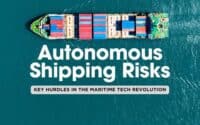How AI and Real-Time Data Are Revolutionizing Port Operations

The maritime industry is setting sail into the future, and AI is at the helm. From real-time sensors that predict mooring stability to digital tools that fine-tune port efficiency, advanced technology is transforming how ships dock, load, and unload. For port operators and shipowners, this isn’t just innovation—it’s a game-changer for safety, efficiency, and sustainability. Here are the top 10 ways AI and real-time data are revolutionizing port operations.

1. Predictive Maintenance for Port Equipment 🛠️
Downtime caused by unexpected equipment failures can derail port operations. Predictive maintenance tools powered by AI are turning this challenge into an opportunity. By analyzing data from cranes, loaders, and other equipment, these systems predict when a component is likely to fail and alert maintenance teams in advance.
- Key Benefit: Increased equipment lifespan and fewer operational disruptions.
- Technology Highlight: Sensors on equipment transmit data to AI platforms, which detect anomalies before failure occurs.
- Cool Fact: Predictive maintenance can cut maintenance costs by 20–30%.
With less downtime and more reliable equipment, ports can keep operations moving smoothly around the clock.
2. AI-Powered Weather Forecasting for Ports 🌦️
Weather can make or break a port’s operational schedule. With AI, ports are now using hyper-local weather forecasting tools that go beyond generic meteorological reports. These systems analyze real-time data on wind, tides, and currents to help ships dock safely and on time.
- Key Benefit: Enhanced scheduling efficiency and reduced weather-related risks.
- Technology Highlight: Machine learning models continuously improve prediction accuracy by analyzing historical and real-time data.
- Cool Fact: AI forecasts can even determine the safest window for unloading perishable goods.
For ports that deal with unpredictable weather, these tools are a lifeline to ensure smooth operations.
3. Real-Time Cargo Tracking Systems 📦
Gone are the days of wondering where your cargo is. With AI and real-time data integration, modern tracking systems offer live updates on cargo movements. These tools enable ports and shipping companies to optimize logistics and reduce bottlenecks.
- Key Benefit: Improved supply chain transparency and efficiency.
- Technology Highlight: RFID and IoT sensors feed data into centralized platforms accessible by multiple stakeholders.
- Cool Fact: Some systems now integrate with blockchain for secure and tamper-proof tracking.
For cargo owners, knowing their goods' exact location is not just a convenience—it’s peace of mind.
4. Smart Berth Allocation Tools ⚓
Every minute a ship waits for a berth costs money. Enter AI-driven berth allocation systems, which consider ship size, cargo type, arrival time, and operational priorities to assign berths efficiently. These tools minimize waiting times and maximize port throughput.
- Key Benefit: Faster turnaround times and reduced congestion.
- Technology Highlight: AI models simulate various allocation scenarios to find the optimal solution.
- Cool Fact: Some ports have reduced ship wait times by up to 30% using these tools.
For busy ports juggling multiple vessels daily, smart berth allocation is a logistical lifesaver.
5. Mooring Stability Systems 🚧
Advancing real-time insights is revolutionizing port operations, enabling smarter decision-making for enhanced efficiency. For example, innovative systems now employ sensors installed at berths to monitor critical variables such as long waves, sea levels, and local agitation. This data is processed through AI models to predict moored ship motions, optimizing operations during loading and unloading.
- Key Benefit: Reduced operational delays and improved safety during mooring.
- Technology Highlight: Sensors integrated into advanced systems ensure seamless data transmission, enabling efficient real-time monitoring and analysis.
- Cool Fact: These technologies can even forecast adverse weather conditions, allowing ports to proactively adjust plans.
Such advancements demonstrate how cutting-edge technology is transforming traditional methods into a precise, data-driven science.
6. Autonomous Tugboat Operations 🚤
Tugboats play a vital role in guiding ships in and out of ports, but manual operations can be costly and time-consuming. AI is enabling autonomous tugboat operations, where vessels are guided by advanced navigation systems and real-time data.
- Key Benefit: Lower operational costs and improved precision during docking.
- Technology Highlight: Autonomous systems use AI to calculate optimal routes and adjust in real time based on conditions.
- Cool Fact: Some systems allow for remote human oversight, blending automation with safety.
For ports looking to modernize, autonomous tugboats are a glimpse into the future of seamless vessel navigation.
7. Energy Optimization Systems 💡
Ports are among the most energy-intensive operations, but AI is helping to turn them green. Energy optimization systems analyze usage patterns and suggest ways to reduce consumption, integrate renewable energy, and improve overall efficiency.
- Key Benefit: Reduced energy costs and lower carbon emissions.
- Technology Highlight: AI-powered platforms monitor energy usage in real time and automate adjustments for peak efficiency.
- Cool Fact: Some ports have integrated solar and wind energy into their grids, with AI ensuring optimal performance.
For ports aiming to meet sustainability goals, these systems are an essential investment.
8. Digital Twin Simulations for Ports 🖥️
A digital twin is a virtual replica of a port, powered by real-time data and AI simulations. Port operators use these digital models to test scenarios, optimize layouts, and identify bottlenecks before making physical changes.
- Key Benefit: Improved planning and reduced trial-and-error costs.
- Technology Highlight: Real-time data from sensors feeds into the digital twin, allowing for dynamic updates and scenario testing.
- Cool Fact: Ports using digital twins have reported a 20% boost in operational efficiency.
With digital twins, ports can experiment virtually to achieve real-world excellence.
9. Enhanced Safety Protocols with AI 🚨
AI is revolutionizing safety in ports by monitoring conditions, identifying risks, and issuing alerts in real time. From detecting unauthorized personnel to identifying potential equipment hazards, these systems add an extra layer of security.
- Key Benefit: Reduced accidents and improved worker safety.
- Technology Highlight: AI-powered cameras and sensors analyze video feeds and data streams for anomalies.
- Cool Fact: Some systems even integrate with wearable technology to monitor workers’ health and alert them to unsafe conditions.
In high-risk environments like ports, smarter safety measures can save lives and reduce liability.
10. Sustainable Port Operations Through Data Integration 🌍
AI and real-time data are driving sustainability across the maritime industry. Ports are integrating systems that track emissions, optimize vessel scheduling, and reduce waste. These tools ensure compliance with environmental regulations while boosting operational efficiency.
- Key Benefit: Achieving sustainability goals without sacrificing efficiency.
- Technology Highlight: Integrated platforms aggregate data from multiple sources to identify areas for improvement.
- Cool Fact: Ports using AI for sustainability have cut emissions by up to 25%.
For ports committed to a greener future, AI is the bridge between ambition and action.
Table Summary
| ShipUniverse: How AI and Real-Time Data Are Revolutionizing Port Operations | ||
|---|---|---|
| Innovation | Description | Cool Fact |
| Advanced Mooring Systems | AI-driven systems analyze sensor data to enhance mooring stability, improving safety and efficiency during loading/unloading. | Capable of anticipating weather-related disruptions to adjust operations proactively. |
| AI-Powered Weather Forecasting | Real-time tools predict wind, tides, and currents to help ports schedule operations more effectively and avoid weather-related disruptions. | Some systems allow hyper-local forecasts down to a single terminal. |
| Real-Time Cargo Tracking | IoT and RFID technologies offer live cargo updates, ensuring transparency and minimizing bottlenecks in logistics. | Blockchain integration ensures tamper-proof tracking. |
| Smart Berth Allocation Tools | AI allocates berths based on ship size, arrival time, and cargo needs, reducing delays and maximizing port capacity. | Ports using these tools have reduced wait times by up to 30%. |
| Predictive Maintenance | AI analyzes equipment data to predict failures, allowing maintenance before issues disrupt port operations. | Can reduce maintenance costs by 20–30%. |
| Autonomous Tugboat Operations | Tugboats equipped with AI navigation systems optimize docking/undocking and reduce labor costs. | Blends automation with human oversight for safety. |
| Energy Optimization Systems | AI monitors and adjusts energy usage, integrating renewables like solar or wind to reduce costs and emissions. | AI-enabled ports have cut energy costs by up to 15%. |
| Digital Twin Simulations | Virtual replicas of ports use real-time data to model scenarios, optimize layouts, and reduce planning errors. | Ports report 20% boosts in efficiency using digital twins. |
| Enhanced Safety Protocols | AI monitors for risks like equipment hazards or unauthorized access, alerting operators in real time. | Some systems integrate with wearable tech for worker safety. |
| Sustainable Port Operations | AI tools track emissions, optimize scheduling, and reduce waste, aligning ports with environmental goals. | Some ports have cut emissions by up to 25% using AI solutions. |

Do you have a Maritime Product or Service that may be of interest to Shipowners? Tell us about it here!
Do you have feedback or insights? Please reach out to editor @ shipuniverse.com



